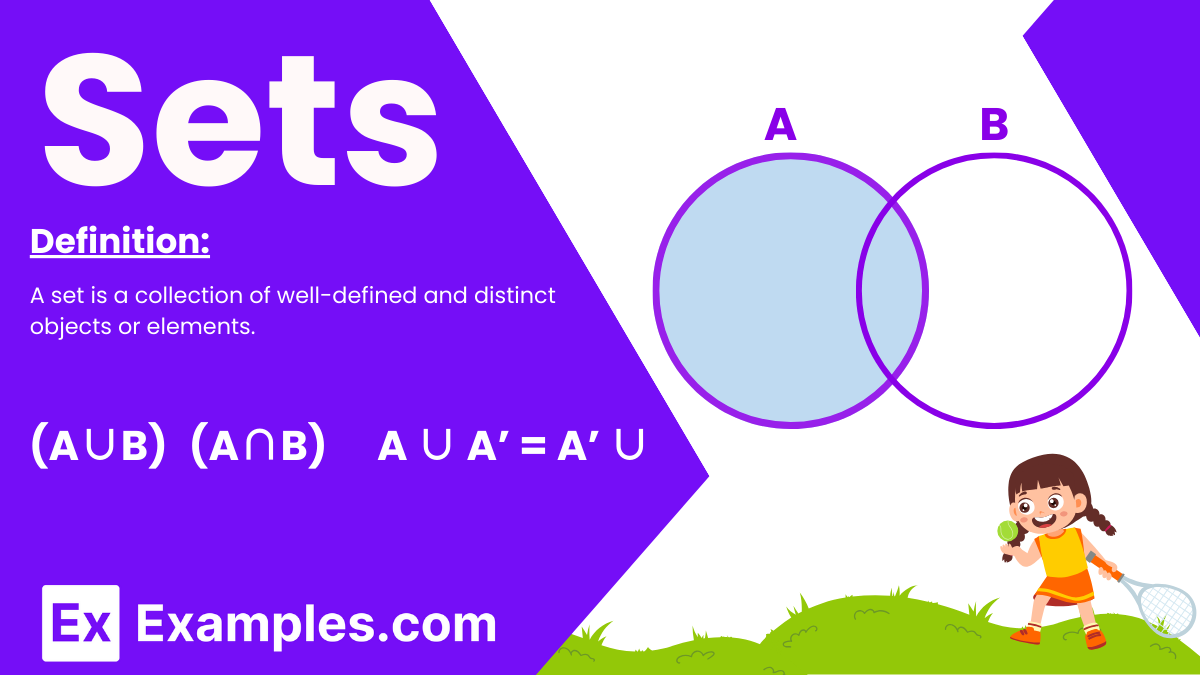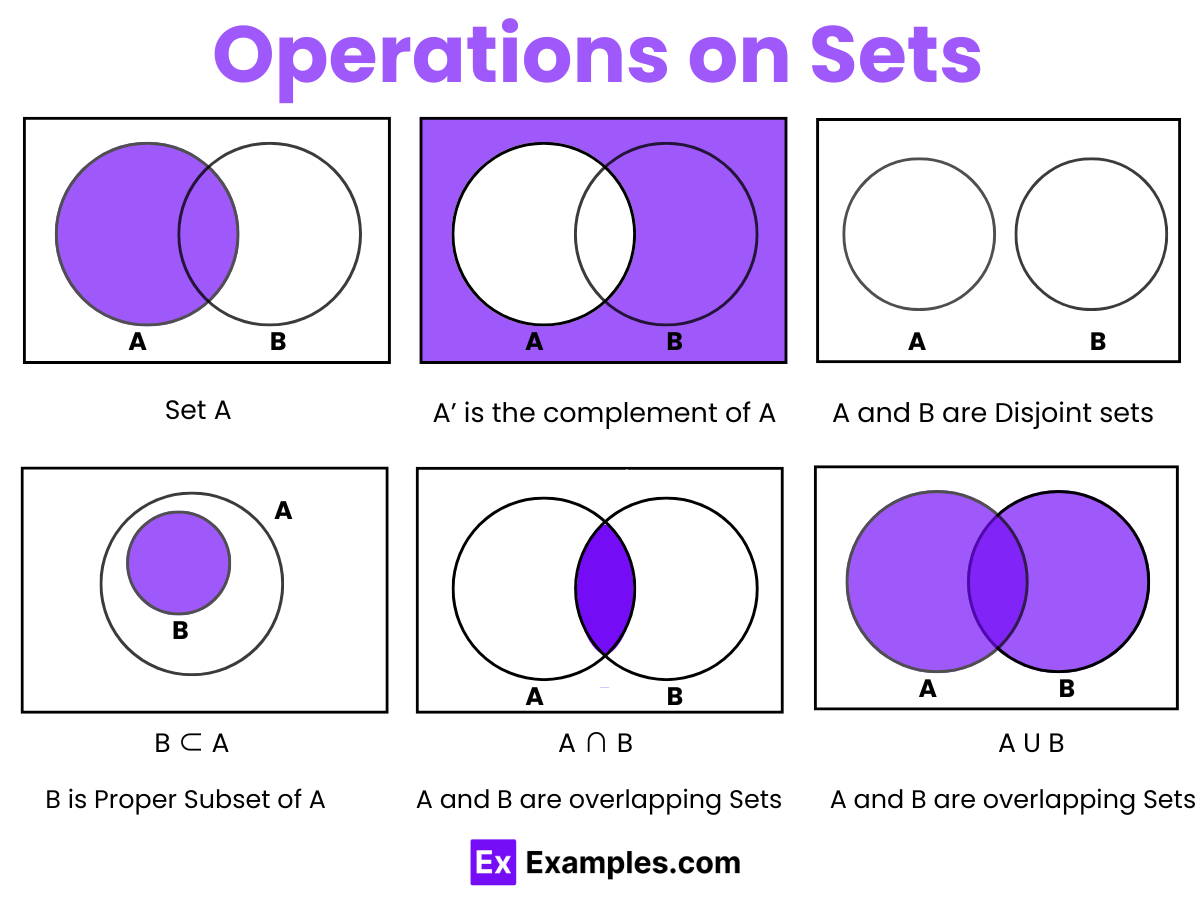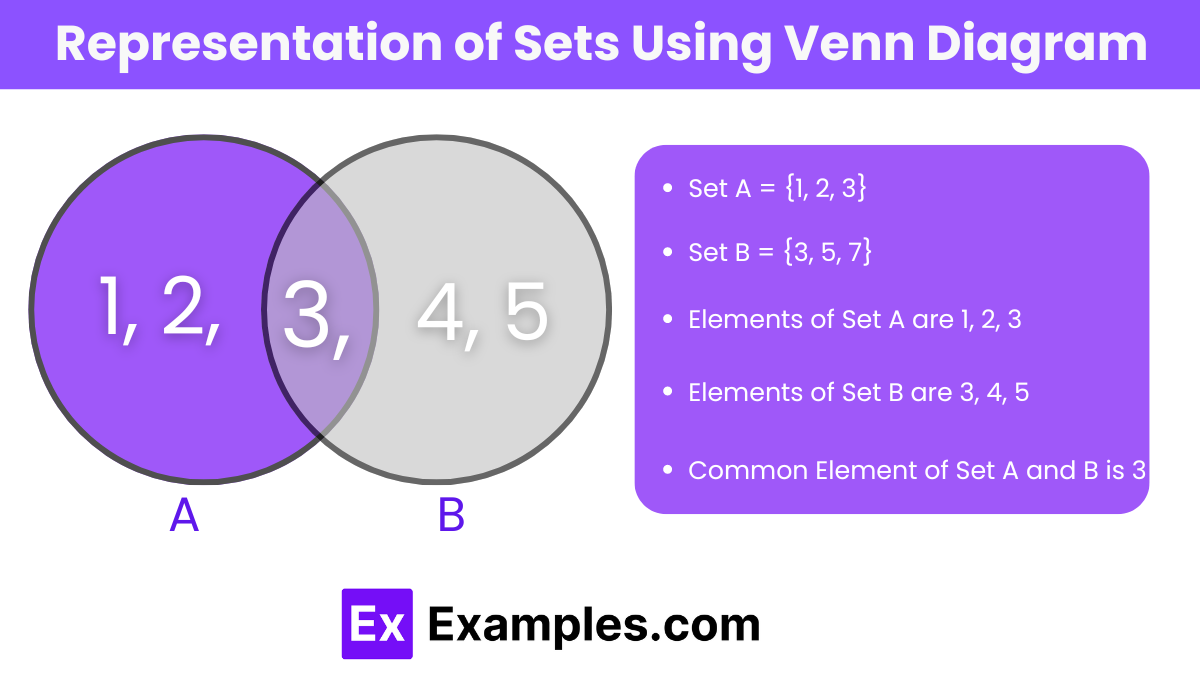Which of the following sets is an example of a finite set?
The set of all natural numbers
The set of all integers
The set of prime numbers less than 20
The set of all real numbers

A set is a collection of well-defined and distinct objects or elements. For instance, the collection of vowels forms a set, as they are clearly defined as “a, e, i, o, u.” Similarly, whole numbers and prime numbers are examples of sets, as their members are uniquely identifiable and consistent.

Operations on sets are fundamental ways to manipulate and combine sets, providing powerful tools in mathematics and computer science. Here are key set operations:
| Formula | Description |
|---|---|
| (A∪B)∪C=A∪(B∪C) | Associative Law (Union): Union operation is associative, meaning grouping order doesn’t matter. |
| (A∩B)∩C=A∩(B∩C) | Associative Law (Intersection): Intersection operation is associative. |
| A∪(B∩C)=(A∪B)∩(A∪C) | Distributive Law (Union over Intersection): Union distributes over intersection. |
| A∩(B∪C)=(A∩B)∩(A∩C) | Distributive Law (Intersection over Union): Intersection distributes over union. |
| (A∪B∪C)ᶜ=Aᶜ∩Bᶜ∩Cᶜ | De Morgan’s Law (Union): The complement of a union is the intersection of the complements. |
| (A∩B∩C)ᶜ=Aᶜ∪Bᶜ∪Cᶜ | De Morgan’s Law (Intersection): The complement of an intersection is the union of the complements. |
| A∪B=B∪A | Commutative Law (Union): Union operation is commutative. |
| A∩B=B∩A | Commutative Law (Intersection): Intersection operation is commutative. |
Here are some key formulas and properties involving three sets A, B, and C:
1.Associative Law (Union): It indicates that the union operation is associative, meaning the grouping order of the sets does not matter.
(A∪B)∪C=A∪(B∪C)
2. Associative Law (Intersection): It indicates that the intersection operation is associative.
(A∩B)∩C=A∩(B∩C)
3. Distributive Law (Union over Intersection): It shows how union distributes over intersection.
A∪(B∩C)=(A∪B)∩(A∪C)
4. Distributive Law (Intersection over Union): This shows how intersection distributes over union.
A∩(B∪C)=(A∩B)∩(A∩C)
5. De Morgan’s Law (Union): This shows the complement of a union is the intersection of the complements.
(A∪B∪C)ᶜ=Aᶜ∩Bᶜ∩Cᶜ
6. De Morgan’s Law (Intersection): This shows the complement of an intersection is the union of the complements.
(A∩B∩C)ᶜ=Aᶜ∪Bᶜ∪Cᶜ
7. Commutative Law (Union): This indicates that the union operation is commutative.
A∪B =B∪A
8. Commutative Law (Intersection): This indicates that the intersection operation is commutative.
A∩B=B∩A
| Formula Expression | Description |
|---|---|
| n(A∪B)=n(A)+n(B)−n(A∩B) | Calculates the number of elements in the union of two sets A and B by adding their individual sizes and subtracting the size of their intersection. |
| n(A∪B)=n(A)+n(B) <br> If 𝐴∩𝐵=∅ | If sets A and B are disjoint (no common elements), the size of their union is simply the sum of their sizes. |
| n(A−B)+n(A∩B)=n(A) | The size of set A can be determined by adding the size of the difference of A and B to the size of their intersection. |
| n(B−A)+n(A∩B)=n(B) | Similarly, the size of set B is the sum of the size of the difference of B and A and the size of their intersection. |
| n(A−B)+n(A∩B)+n(B−A)=n(A∪B) | The total number of elements in the union of A and B can be found by adding the sizes of the differences and their intersection. |
| n(A∪B∪C)=n(A)+n(B)+n(C)−n(A∩B)−n(B∩C)−n(C∩A)+n(A∩B∩C) | This formula calculates the number of elements in the union of three sets A, B, and C by considering all possible intersections to avoid over-counting elements present in multiple sets. |
| Commutative Property : A∪B = B∪A A∩B = B∩A |
| Associative Property : A ∪ ( B ∪ C) = ( A ∪ B) ∪ C A ∩ ( B ∩ C) = ( A ∩ B) ∩ C |
| Distributive Property : A ∪ ( B ∩ C) = ( A ∪ B) ∩ (A ∪ C) A ∩ ( B ∪ C) = ( A ∩ B) ∪ ( A ∩ C) |
| De morgan’s Law : Law of union : ( A ∪ B )’ = A’ ∩ B’ Law of intersection : ( A ∩ B )’ = A’ ∪ B’ |
| Complement Law : A ∪ A’ = A’ ∪ A =UA ∩ A’ = ∅ |
| Idempotent Law And Law of a null and universal set : For any finite set A A ∪ A = A A ∩ A = A ∅’ = U ∅ = U’ |
In set theory, various notations are used to represent sets, each offering a unique way to list elements:
| Set of first five even natural numbers | ||
|---|---|---|
| Semantic Form | Roster Form | Set Builder Form |
| A set of first five even natural numbers | {2, 4, 6, 8, 10} | {x ∈ ℕ | x ≤ 10 and x is even} |

A Venn Diagram is a visual representation of sets, with each set shown as a circle. The elements of a set are placed inside its respective circle. Often, the circles are enclosed by a rectangle, which represents the universal set. Venn diagrams illustrate how sets relate to one another by showing intersections, unions, and differences, making them a powerful tool for understanding set operations and relationships.
| Symbol | Meaning |
|---|---|
| ∈ | Indicates membership of an element in a set. For example, 𝑎∈𝐴 means 𝑎a is an element of set A. |
| ∉ | Indicates that an element is not a member of a set. For example, 𝑏∉𝐵 means b is not in set B. |
| ⊆ | Indicates that set A is a subset of set B (i.e., all elements of A are in B). |
| ⊂ | Indicates that set A is a proper subset of set B (i.e., all elements of A are in B and B has other elements not in A). |
| ∩ | Represents the intersection of two sets, which includes elements common to both sets. |
| ∪ | Represents the union of two sets, which includes all elements that are in either set. |
| − | Represents the difference between two sets A and B, including elements that are in A but not in B. |
| △ | Represents the symmetric difference between two sets, including elements that are in one set or the other, but not both. |
| ∅ | Represents the empty set, which contains no elements. |
| × | Represents the Cartesian product of two sets, which consists of all ordered pairs formed by elements from both sets. |
| 𝐴𝑐 | Represents the complement of set A, which includes all elements not in A but in the universal set U. |
Given three sets A,B, and C such that 𝐴={1,2,3,4,5}, 𝐵={3,4,5,6,7}, and 𝐶={5,6,7,8,9}, answer the following:
Let sets 𝐴 and 𝐵 be defined as follows:
𝐴={𝑥∣𝑥 is an integer, and 1≤𝑥≤10}
𝐵={𝑥∣𝑥 is an integer, and 5≤𝑥≤15}
The formula 𝑛(𝐴∪𝐵)=𝑛(𝐴)+𝑛(𝐵)−𝑛(𝐴∩𝐵) calculates the number of elements in the union of two sets by adding their individual sizes and subtracting the size of their intersection, avoiding double counting.
In mathematics, a set is a collection of distinct and well-defined elements, such as numbers, letters, or symbols. Sets are fundamental to various mathematical concepts and operations, providing a structure for organizing and manipulating elements in disciplines like algebra and logic.
A null set, or empty set, is called a set because it adheres to the definition of a set—a collection of distinct, well-defined elements. In this case, it is a set with no elements, but still conforms to set properties.
In set notation, Z denotes the set of all integers, encompassing positive, negative, and zero integers. This notation is derived from the German word “Zahlen,” meaning numbers, and is widely used in mathematical contexts.
A unit set, also known as a singleton set, contains only one element. For example, the set A={7} is a unit set because it has a single, distinct element, which makes it unique compared to sets with multiple elements.
Text prompt
Add Tone
10 Examples of Public speaking
20 Examples of Gas lighting
Which of the following sets is an example of a finite set?
The set of all natural numbers
The set of all integers
The set of prime numbers less than 20
The set of all real numbers
Which set notation represents the set of all elements that are either in set A or in set B?
A ∩ B
A - B
A ∪ B
A ⊂ B
What does the intersection of two sets A and B contain?
All elements in set A but not in set B
All elements in set B but not in set A
All elements that are in both set A and set B
All elements that are in either set A or set B
What is the power set of a set with three elements?
2³
3²
2²
3³
Which of the following is a subset of the set {1, 2, 3, 4}?
{5, 6}
{2, 4}
{0}
{1, 2, 5}
If set A = {2, 4, 6} and set B = {1, 2, 3}, what is A ∩ B?
{1, 3, 6}
{2}
{2, 4}
{4, 6}
What is the difference between sets A and B, where A = {1, 2, 3} and B = {2, 3, 4}?
{1, 4}
{2, 3}
{1}
{4}
What is the universal set when dealing with the sets {1, 2, 3} and {2, 3, 4}?
{1, 2, 3, 4}
{2, 3}
{1, 2, 3}
{2, 3, 4}
Which of the following is not a valid operation for sets?
Union
Intersection
Difference
Division
If A = {a, b, c} and B = {b, c, d}, which of the following is true?
A ⊂ B
B ⊂ A
A ⊆ B
B ⊆ A
Before you leave, take our quick quiz to enhance your learning!

